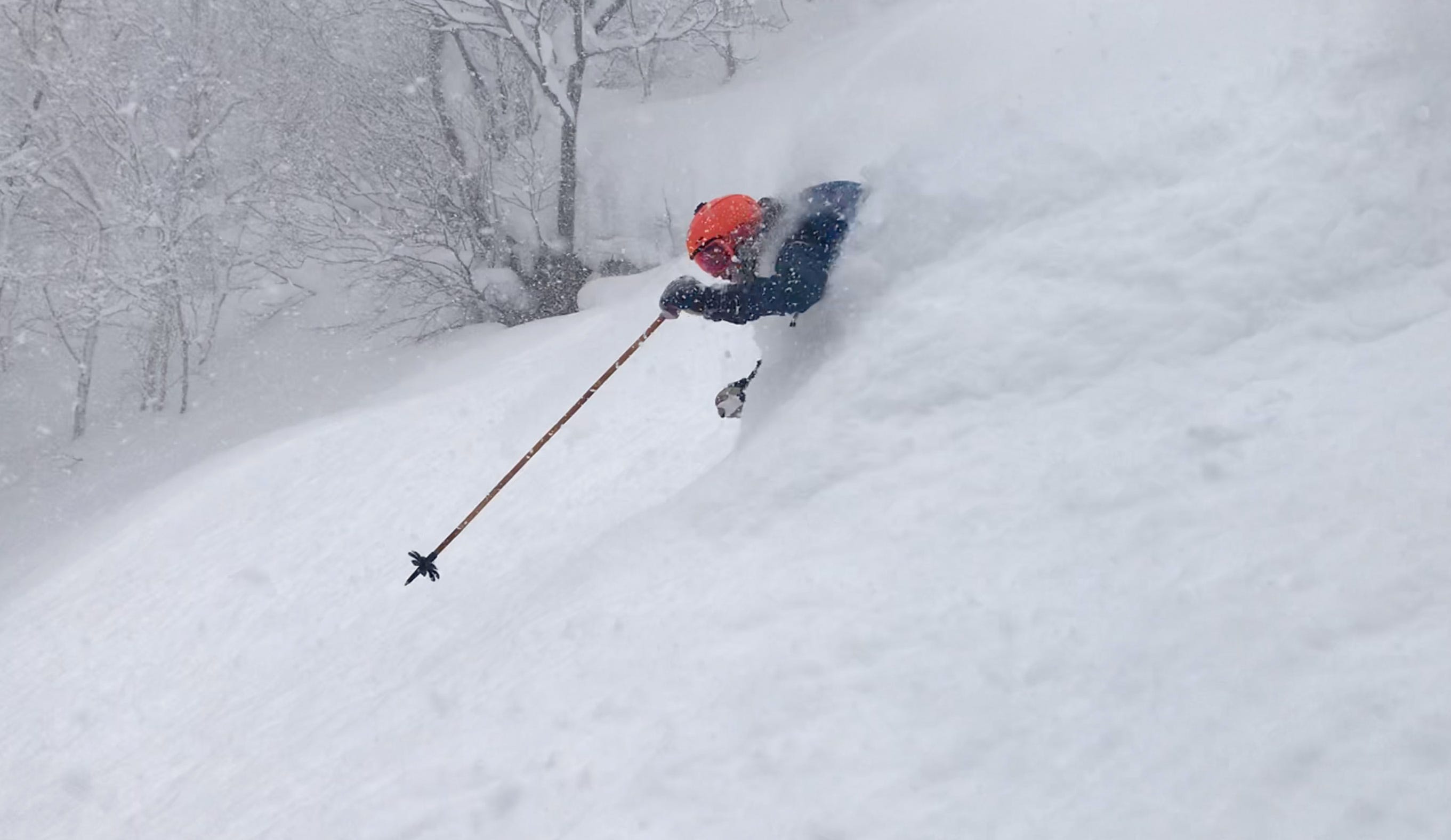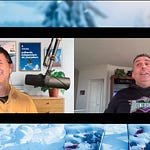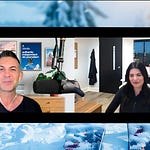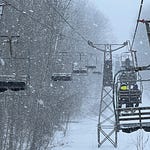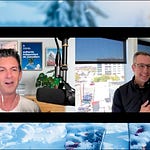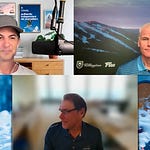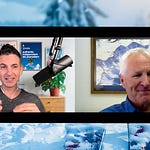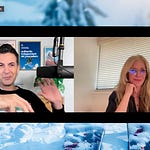Who
Joel Gratz, Founding Meteorologist and CEO of OpenSnow
Recorded on
November 17, 2022
About OpenSnow
OpenSnow is a snow and weather forecasting service. It gives you all this, depending on whether or not you want to pay for it:
Gratz founded OpenSnow 11 years ago with an email list of 37 people. The company’s list now numbers 3 million. Or so. It’s like counting flakes in a storm. There are lots of them. The service pinpoints snowfall everywhere on the planet. So Backcountry Bro, you’re covered. Lift-Served Larry (that’s me), you’re covered too. Uphill Harvey – we really wish you’d just pick a side and stop fucking up the grooming before the lifts open.
Anyway, if you love snow and want to know how much of it is going to fall, and where and when, then this app should be your Excalibur. Wield it wisely, Fellow Snowbum.
Why I interviewed him
You know how some people want to live in Florida and make exasperated sounds when more snow materializes on the radar and plan wintertime vacations to places like Aruba? Well I am not one of those people. And neither is Joel Gratz. Wintertime is for skiing. And to enjoy skiing as much as possible, it helps to follow the snow around. That’s what Joel, and his brilliant website/app/service, OpenSnow, do.
Everyone reading this newsletter is programmed in a different way from Human V1.0. We run toward storms that most humans flee. With urgency. Like some snowy version of a firefighter. Like insane people. Because we know what the genuflecting and hysterical weatherman does not: that snow is potent and intoxicating; that it changes the world and everything in it, including the people who immerse themselves within. If an adult charges into a sandbox or waterpark or ballpit, we regard them suspiciously. That stuff is for kids. But if they spend the day bouncing through snow and enter the bar boot-clicking and semi-dazed and white-draped and grinning madly and asking for a tallboy, we ask them to stand up at our wedding.
No one gets this but skiers. And so no one could make a truly ski-centric weather app other than a skier. Someone whose headline, upon analyzing an incoming storm, isn’t DEAR GOD DO NOT STEP OUTSIDE STOCK UP ON AMMUNITION AND DRY RATIONS BECAUSE THIS IS IT PEOPLE, but rather DEAR GOD IT’S ABOUT TO SNOW 90 INCHES IN TAHOE GET THERE AS FAST AS POSSIBLE!
There are plenty of ways to track the weather, of course. Lots of apps, lots of weather services, lots of social media groups. I haven’t found one better than OpenSnow, where I can look up any specific ski area and see an hour-by-hour and day-by-day snowfall and weather forecast for 10 days into the future. And that’s all I really care about: where will it snow, how much, and when? With a meteorology degree on his wall and a couple decades in his mad-scientist’s snow lab, Gratz is as well-equipped to deliver this information as anyone on the planet.
What we talked about
How early a ski weather guy wakes up; Joel’s wintertime and powder-day routine; the secrets of good powder skiing; how a meteorologist was born; Shawnee, Pennsylvania; do they even want snow in the Poconos?; Penn State meteorology; skiing Tussey; an Alpine Meadows powder day on racing skis; Boulder as innovation incubator; how a Vail old-timer outsmarted the guy with the fancy meteorology degree; the mystery of mountain microclimates; the missed Steamboat powder day that inspired the creation of OpenSnow; an email goes out to 37 people on a Tuesday night; a fortuitous conversation with Chris Davenport; how long it took OpenSnow to really establish itself; “a lot of your good fortune is just being born when and where you were”; the several simultaneous tech innovations that enabled widespread online weather forecasting; breaking down the various global weather services (GFS, Euro, etc.), and how they work; “modern meteorology is a miracle of cooperation and funding from taxpayers like us all around the world”; translating raw data and forecasts into the thing skiers most care about: how much is it going to snow, when, and where?; removing the human from the forecasting equation; why and how OpenSnow scaled from Colorado to the rest of the world; why OpenSnow doesn’t capture every ski area in the world (yet); snow forecasts for any mapdot on the planet; why OpenSnow shifted to a subscription model and what it meant for the business; La Niña; breaking down the strong early start for the West and the weak weather in New England; dumb meteorology jokes; the two things you need to make snow; breaking down the unique weather systems that determine snowfall for the Cottonwoods, Mt. Baker, Keystone, Tahoe, the Great Lakes, and northern Vermont; how wind impacts snow quality; and America’s snowiest places.
Why I thought that now was a good time for this interview
The image in the “About OpenSnow” section above distills the benefits of the paid subscription tier succinctly: to tap the service’s best features, you need to pay. It’s worth it. I subscribed long before our partnership, and I continue to.
But OpenSnow wasn’t always so arranged. For years, Gratz and his team lived on advertising. At some point, they activated a paywall to access certain features, but much of the site remained free.
That changed last year, when OpenSnow migrated the majority of its content to its paid tier. Gratz explains why in the podcast, but this business decision resonated with me for obvious reasons. To remain relevant and useful, most digital ski-focused media platforms require an intense and consistent focus. That requires time, energy, passion, and commitment – all attributes that our capitalist society has deemed worth paying for in the form of labor. Labor, we decided a long time ago, cannot be free. Thus, products produced with labor – and media is a product – require a pricetag to access.
This is easier to understand when you’re purchasing a toaster or a car than when you’re buying access to a podcast or a snow forecast. It helps to remember that, in the scope of history, the internet is still pretty new. I grew up without it, and I’m not that old. We’re still figuring out how to price the considerable volume of information that we find there. Most of it, I’ll admit, is worthless, but some of it is worth quite a bit. But several generations of Americans arrived at the internet with the understanding that it was a frivolous add-on, a place to waste time and get in trouble, a soul vacuum that was the domain of creeps and morons. They have a hard time acknowledging the evolution of the web into a utility, an essential pipeline of connection and information, a place of intangible things with tangible value.
That was the challenge OpenSnow faced in finding a path to long-term sustainability. And it is the challenge I face with The Storm. I did it for free for as long as I could. The first 2,076 hours of labor were on me. Then I asked for money. The transition went beyond my expectations. Hundreds of people upgraded their subscriptions right away, and hundreds more have upgraded since. New paid subscribers join just about every day. The Storm is now a sustainable operation. And so, having made the same decision – on a much larger scale – is OpenSnow.
I’m sure you’ve read about the Great Pacific Garbage Patch, a rat’s nest of floating plastic refuse covering more than 600,000-square-miles of the Pacific Ocean. Most of its contents are microplastics – the smashed-up bits of water bottles and medicine containers and candy-bar wrappers. You just know that floating somewhere in there is a Yeti cooler and fully intact G.I. Joe hovercraft (I keep waiting for Disney to release: Toy Story: Tales of the Garbage Patch, featuring a scrappy band of discarded toys who A-Team their way back to the mainland), but most of it is useless garbage.
The internet is a lot like the Great Pacific Garbage Patch: an unfathomable well of junk, sprinkled with a few treasures. There’s a reason I occasionally step out of my ski-area-manager lane to interview journalists or individuals running ski-related websites: I want to help you find the G.I. Joe Killer W.H.A.L.E.s, the things worth scooping out of the water and taking home.
Why you should use OpenSnow
While OpenSnow is a Storm advertising partner, this podcast was not part of, and is not related to, that partnership. OpenSnow did not have any editorial input into the content or editing of this podcast - which is true of any guest on any episode. I don’t do sponsored content. The Storm is independent ski media, based on reporting and independently verified facts - any opinion is synthesized through that lens, as it is with any good journalism outlet.
That said, it’s a great service, and one that I use every day of the winter – that’s why I partnered with them. And part of our partnership is this special link where you can get two free months of OpenSnow. So you should probably take advantage of that so they want to keep working with me:
Podcast Notes
Joel references Baker’s record snowfall year – it was 1,140 inches from 1998 to ’99. You can read about that and some other big snow totals here.
The Storm publishes year-round, and guarantees 100 articles per year. This is article 133/100 in 2022, and number 379 since launching on Oct. 13, 2019. Want to send feedback? Reply to this email and I will answer (unless you sound insane, or, more likely, I just get busy). You can also email skiing@substack.com.





